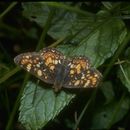en
names in breadcrumbs


US Federal List: no special status
CITES: no special status
Ecosystem Impact: pollinates
Phyciodes campestris larvae feed communally until half grown and then again during winter months. Caterpillars feed on various asters (Aster and Machaeranthera species) throughout their development. As the field crescent matures into an adult, flower nectar -a solution of sugars, water, and occasional amino acids, becomes the primary source of nourishment.
Plant Foods: leaves; nectar
Primary Diet: herbivore (Folivore , Nectarivore )
The field crescent butterfly spans the shores of the Arctic Ocean from Canada south to Mexico. This species is most commonly spotted flying at low to middle altitudes in the Rocky Mountains, and in higher mountains of the Northwest United States. Phyciodes campestris occupies central Alaska, the Mackenzie District of the Northwest and Saskatchewan territories in Canada, California, Arizona, New Mexico, as well as the western edge of the Great Plains.
Biogeographic Regions: nearctic (Native )
This species lives in flat open areas such as fields, meadows, forest clearings, grassland valleys, and swamps. The field crescent also dwells along canals and streamsides. In the northern part of the geographic range, Phyciodes campestris can be found almost anywhere, from plains to mountains, as well as in taiga -a broad subarctic band where the winters are long and cold. In the far northwestern part of its range, the habitat changes into arctic-alpine meadows, and fell-fields.
Habitat Regions: temperate
Terrestrial Biomes: taiga ; savanna or grassland ; scrub forest ; mountains
Other Habitat Features: riparian
The field crescent butterfly is generally quite small with a wingspan of 1 -1.5 inches (2.5-4.5 cm). The wings on the upper side are orange and brown with black margins, spots, and lines, while the underside of the wings reproduce these same spots in paler tints. The under side of the forewing is yellow-brown with a yellow arch at the cell, and the under side of the hindwing is yellow-brown with rusty markings. Of the spots on the underside of the wing, the most characteristic of Phyciodes campestris is the pale crescent situated on the outer margin of the hind wing. This spot is frequently pearly-white or silver colored.
Eggs are a pale-yellow-green, and are always longer than broad, with the surface at the base more or less pitted giving them a thimble-like appearance.
Phyciodes campestris larvae are patterned a darker, blackish brown with black heads. Weak cream dorsal strips and a lighter crescent strip adorn the body and eyes. They have tubercles arranged in regular rows.
The chrysalis, a protective structure during pupation, is a light mottled grey to brown, pendant shaped, and has small bumps along the dorsal region of the abdomen.
Range wingspan: 2.5 to 4.5 mm.
Other Physical Features: ectothermic ; bilateral symmetry
Males patrol just above the meadows during the day in search for females. After mating,females slowly flutter through the vegetation looking for a place to lay their eggs.
The eggs are a pale-yellow-green, laid singly in large clusters on the underside of host leaves, especially on young plants.
Key Reproductive Features: sexual ; fertilization (Internal ); oviparous
After eggs are layed on a suitable host plant, there is no further parental investment.
Parental Investment: pre-fertilization (Provisioning, Protecting: Female)
Phyciodes pratensis est une espèce d'insectes lépidoptères (papillons) de la famille des Nymphalidae, de la sous-famille des Nymphalinae et du genre Phyciodes.
Phyciodes pratensis a été nommé par Behr en 1863.
Pour certains auteurs c'est une espèce à part entière, pour d'autres auteurs c'est Phyciodes pulchera pulchella une sous-espèce de Phyciodes pulchella (Boisduval,1852)[1],[2]
Phyciodes pratensisa se nomme Field Crescentspot en anglais[3].
Phyciodes pratensis est un papillon de couleur noire à lignes de damiers orange. Sur le dessus les ailes antérieures présentent une large bordure marron puis entre des lignes marron à noir, une ligne de damier rouge orangé et une ligne de damiers jaune orangé. Les ailes postérieures présentent une ligne submarginale de fins chevrons orange dans la bordure marron et une ligne de points marron dans des taches rouge orangé puis une ligne de damiers jaune orangé.
Le revers est plus clair, avec des antérieures à damiers jaunes et orangés et peu de marron et des postérieures avec des limites discrètes formant des damiers ocre clair et sable.
Son envergure est comprise entre 25 et 45 mm[3].
La chenille de couleur noire est ornée d'épines à base orange[1].
Phyciodes pratensis vole en une seule génération de mai à août dans les montagnes du nord de son aire, deux générations entre mai et septembre en plaine, trois à quatre entre avril et octobre en Californie[1],[3].
Il hiverne au stade de chenille[3].
Les plantes hôtes des chenilles sont des asters[1].
Il est présent dans tout l'ouest de l'Amérique du Nord, du centre de l'Alaska et de l'ouest du Canada en Colombie-Britannique à tout l'ouest des USA jusqu'au sud de la Californie, de l'Arizona et du Nouveau-Mexique[3].
Il réside dans les clairières, les champs, sur les bords des routes[1].
Pas de statut de protection particulier[3].
Phyciodes pratensis est une espèce d'insectes lépidoptères (papillons) de la famille des Nymphalidae, de la sous-famille des Nymphalinae et du genre Phyciodes.
Phyciodes campestris is een vlinder uit de familie Nymphalidae.[1] De wetenschappelijke naam van de soort is voor het eerst geldig gepubliceerd in 1863 door Hans Hermann Behr.
Bronnen, noten en/of referenties